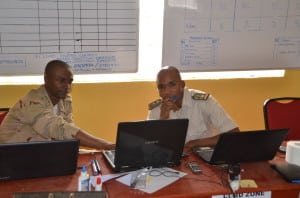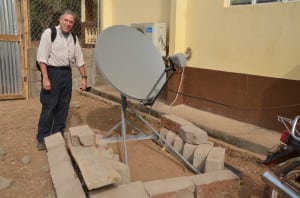Latest News
[Via Satellite 01-26-2015] Gisli Olafsson, emergency response director at NetHope, a consortium of 42 top global humanitarian organizations, has been in West Africa as part of the international response to the Ebola outbreak since October 2014. He has traveled between Ghana, Sierra Leone and Liberia, spurring on the use of Information and Communications Technology (ICT) to combat the disease throughout the three countries.
Telecommunications infrastructure, a vital part of any emergency response, is often very basic in rural parts of Africa. Most of the time in these regions, General Packet Radio Service (GPRS) is the fastest mobile data network available, while in the absolute most rural areas, there is no mobile signal at all. In an interview with Via Satellite, Olafsson said the influx of responders into affected rural areas has put pressure on already fragile networks.
Fortunately, there has been an unparalleled response by the satellite industry.
While the industry is often called upon to restore communications in the wake of natural disasters, the Ebola outbreak is different in that the affected area is much larger than a typical disaster.
“In a natural disaster you have a path of destruction,” explained Olafsson. “This path of destruction damages the critical telecommunication infrastructure in that area. Here there was no damage of critical infrastructure. The outbreak however affected the entire three countries, including very remote areas with no existing infrastructure. This led to us having to provide services over a much larger area than we have ever had to deal with before. Overall the response community has brought over 250 mobile satellite terminals and over 100 VSATs into the three countries. This is a scale we have never seen before.”
NetHope has been deploying more than 120 mobile broadband terminals such as Thuraya’s IP+ and Inmarsat’s Broadband Global Area Network (BGAN) terminals, as well as more than 50 VSATs. Companies such as Eutelsat and Facebook have also contributed satellite equipment. The majority of the installations have been in rural areas where connectivity was close to non-existent before. This infrastructure is aiding in bringing a halt to the febrile disease’s spread, which can resurface up to 90 days after the last survivor is released.
“We have been very fortunate that our supporters have enabled us to perform a phased approach to this emergency. In the first phase we brought mobile satellite terminals such as IP+ and BGANs. These are easy to transport and deploy to remote areas. In the second phase we brought in VSATs or boosted the bandwidth of existing VSAT installations across the three countries. The third phase is then extending connectivity from existing backhauls — terrestrial or satellite — out to nearby locations using point to point wireless technology,” said Olafsson.
As NetHope transitions through these phases, equipment is reallocated along the way. Mobile broadband Internet terminals from the first phase are replaced with VSATs, freeing up the mobile terminals for teams that roam between new cases of the disease. NetHope has also worked closely with local Mobile Network Operators (MNOs) to leverage critical infrastructure on behalf of member organizations. Olafsson said the cooperation has been very beneficial, and commended such operators for their work during trying times.

Responders use connectivity by satellite and other means to coordinate the response to Ebola. Photo: NetHope
“They are doing a great job in very difficult environment. This outbreak is on such a scale that it is crucial for the international and local communities to work closely together. No one country can tackle outbreaks of this scale,” he said.
Member organizations within NetHope as well as other response organizations have benefited from satellite communications to share information and react effectively to contain Ebola. In addition to combating the disease, Ebola responders have been able to use the connectivity provided by these resources to stay in contact with family in friends. Olafsson highlighted that the morale-boosting effect of connecting socially to concerned people far away has had an invaluable impact.
Unfortunately, there are more consequential challenges that follow controlling the Ebola crisis. Many families have lost breadwinners, creating orphans, and the inability to plant seeds is causing food insecurities. Olafsson said satellite communications will continue have a long-term role in recuperating the region.
“As the clinical aspects (stopping the outbreak) start coming to a close, the humanitarian aspects will take a more central role. Rebuilding the countries after a yearlong outbreak will take time. Coordinating this effectively through well connected offices and facilities will continue to be critical in the months to come,” he said.
Stay connected and get ahead with the leading source of industry intel!
Subscribe Now